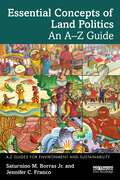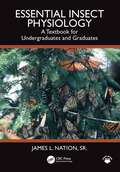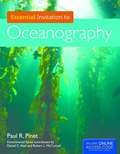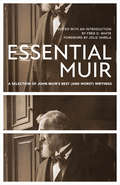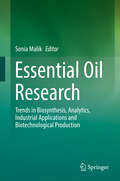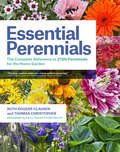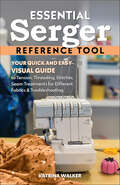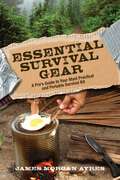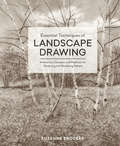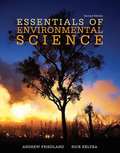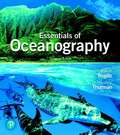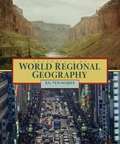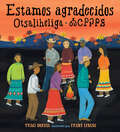- Table View
- List View
Escape From Hell
by V. A. StuartWith the Sepoy Mutiny still threatening British lives in India, Commander Phillip Hazard volunteers to accompany a special army force to rescue the besieged British garrison at Ghorabad. Hazard and the men of the Shannon's Naval Brigade are put under the command of Colonel Cockayne, a cavalry officer whose own wife and daughter are among those caught in the siege. In this final book of the Hazard series, Hazard finds himself in the thick of the battle, desperately trying to rescue survivors and facing the dangers and betrayals that come with command and war.
Escape from Lucania: An Epic Story of Survival
by David RobertsIn 1937, Mount Lucania was the highest unclimbed peak in North America. Located deep within the Saint Elias mountain range, which straddles the border of Alaska and the Yukon, and surrounded by glacial peaks, Lucania was all but inaccessible. The leader of one failed expedition deemed it "impregnable." But in that year, a pair of daring young climbers would attempt a first ascent, not knowing that their quest would turn into a perilous struggle for survival. Escape from Lucania is their remarkable story.Classmates and fellow members of the Harvard Mountaineering Club, Brad Washburn and Bob Bates were two talented young men -- handsome, intelligent, and filled with a zest for exploring. Both were ambitious climbers, part of a small group whose first ascents in the great mountain ranges during the 1930s and 1940s changed the face of American mountaineering. Setting their sights on summitting Lucania in the summer of 1937, Washburn and Bates put together a team of four climbers for the expedition. But when Bates and Washburn flew to the Walsh Glacier at the foot of Lucania, they discovered that freakish weather conditions had turned the ice to slush. Their pilot was barely able to take off again alone, and there was no question of returning with the other two climbers or more supplies. Washburn and Bates found themselves marooned on the glacier, more than a hundred miles from help, in forbidding and desolate territory. Eschewing a trek out to the nearest mining town -- eighty miles away by air -- they decided to press ahead with their expedition. Escape from Lucania recounts Washburn and Bates's determined drive toward Lucania's 17,150-foot summit under constant threat of avalanches, blinding snowstorms, and hidden crevasses. Against awesome odds they became the first to set foot on Lucania's peak, not realizing that their greatest challenge still lay beyond. Nearly a month after being stranded on the glacier and with their supplies running dangerously low, they would have to navigate their way out through uncharted Yukon territory, racing against time as the summer warmth caused rivers to swell and flood to unfordable depths. But even as their situation grew more and more desperate, they refused to give up. Escape from Lucania tells this amazing story in thrilling and vivid detail, from the climbers' exultation at reaching the summit to their darkest moments confronting seemingly insurmountable obstacles. It is a tale of awesome adventure and harrowing danger. But above all it is the story of two men of extraordinary spirit, inspiring comradeship, and great courage. Today Washburn and Bates, now in their nineties, are legends in climbing circles. Bates co-led 1938 and 1953 expeditions to K2, the world's second-highest mountain. Washburn, whose record of Alaskan first ascents is unmatched, became founding director of Boston's Museum of Science and is one of the premier mountain photographers in the world. Some of his remarkable images from the 1937 Lucania expedition are included in this book.
Escaping Nature: How to Survive Global Climate Change
by Orrin H. Pilkey Keith C. Pilkey Norma J. Longo Hannah L. Hayes Charles O. Pilkey Linda P. Pilkey-Jarvis Fred B. DodsonIndustrial and agricultural greenhouse gas emissions are rapidly warming Earth’s climate, unleashing rising seas, ocean acidification, melting permafrost, powerful storms, wildfires, floods, deadly heat waves, droughts, tsunamis, food shortages, and armed conflict over shrinking water supplies while reducing nutritional levels in crops. Billions of people will become climate refugees. Hotter temperatures will allow tropical diseases to spread into temperate regions. Higher levels of CO2, allergens, dust, and other particulate matter will impair our physical and mental health and even reduce our cognitive abilities. Climate change disproportionately affects the world’s poor. It also harms Nature, and could ultimately trigger a sixth mass extinction. In Escaping Nature, Orrin H. Pilkey and his coauthors offer concrete suggestions for how to respond to the threats posed by global climate change. They argue that while we wait for the world’s governments to get serious about mitigating climate change we can adapt to a hotter world through technological innovations, behavioral changes, nature-based solutions, political changes, and education.
Escaping the Dark, Gray City: Fear and Hope in Progressive-Era Conservation
by Benjamin Heber JohnsonA compelling and long-overdue exploration of the Progressive-era conservation movement, and its lasting effects on American culture, politics, and contemporary environmentalism The turn of the twentieth century caught America at a crossroads, shaking the dust from a bygone era and hurtling toward the promises of modernity. Factories, railroads, banks, and oil fields—all reshaped the American landscape and people. In the gulf between growing wealth and the ills of an urbanizing nation, the spirit of Progressivism emerged. Promising a return to democracy and a check on concentrated wealth, Progressives confronted this changing relationship to the environment—not only in the countryside but also in dense industrial cities and leafy suburbs. Drawing on extensive work in urban history and Progressive politics, Benjamin Heber Johnson weaves together environmental history, material culture, and politics to reveal the successes and failures of the conservation movement and its lasting legacy. By following the efforts of a broad range of people and groups—women’s clubs, labor advocates, architects, and politicians—Johnson shows how conservation embodied the ideals of Progressivism, ultimately becoming one of its most important legacies.
Escaping the Resource Curse (Initiative for Policy Dialogue at Columbia: Challenges in Development and Globalization)
by Jeffrey D. Sachs Joseph E. Stiglitz Eds. Humphreys MacartanThe wealth derived from natural resources can have a tremendous impact on the economics and politics of producing countries. In the last quarter century, we have seen the surprising and sobering consequences of this wealth, producing what is now known as the "resource curse." Countries with large endowments of natural resources, such as oil and gas, often do worse than their poorer neighbors. Their resource wealth frequently leads to lower growth rates, greater volatility, more corruption, and, in extreme cases, devastating civil wars. In this volume, leading economists, lawyers, and political scientists address the fundamental channels generated by this wealth and examine the major decisions a country must make when faced with an abundance of a natural resource. They identify such problems as asymmetric bargaining power, limited access to information, the failure to engage in long-term planning, weak institutional structures, and missing mechanisms of accountability. They also provide a series of solutions, including recommendations for contracting with oil companies and allocating revenue; guidelines for negotiators; models for optimal auctions; and strategies to strengthen state-society linkages and public accountability. The contributors show that solutions to the resource curse do exist; yet, institutional innovations are necessary to align the incentives of key domestic and international actors, and this requires fundamental political changes and much greater levels of transparency than currently exist. It is becoming increasingly clear that past policies have not provided the benefits they promised. Escaping the Resource Curse lays out a path for radically improving the management of the world's natural resources.
Esculturas de la naturaleza (¡Arriba la Lectura!, Level M #25)
by Margaret FettyQuizá no lo sabías, pero el viento, el agua y el hielo transforman el suelo. Estas fuerzas actúan por millones de años y crean esculturas en la naturaleza. Descubre cómo lo hicieron y qué formas asombrosas crearon. NIMAC-sourced textbook
Essays in Economics: Theories, Theorizing, Facts And Policies
by Wassily W. LeontiefFirst Published in 2015. Routledge is an imprint of Taylor & Francis, an Informa company.
Essays on Sustainability and Management
by Runa Sarkar Annapurna ShawThis book offers a comprehensive overview of sustainability and management in India and through its insightful essays highlights the complex and multifaceted nature of sustainability as a concept. It also demonstrates the debates surrounding the concept of sustainability and its ramifications for ground-level practice in managing organisations and for public policy. The contributions from sustainability enthusiasts, practitioners from disparate fields and academics working at the Indian Institute of Management Calcutta, have been divided into five themes: (1) sustainability as a normative concept; (2) sustainability concept at the global level, (3) sustainability practices in Indian organisations and consumer behaviour; (4) sustainability, corporate governance and corporate social responsibility and (5) sustainability: a critique of organisational practice and government regulation. The themes reflect both new and continuing issues confronting management in the country today. Examples and in-depth studies make it relevant to the grounded reality in India. The expertise and experience of the contributors ensure that readers are left with a grasp of our current understanding of how sustainability is related to society and business, the direction this understanding will take in the future.
Essence and Ember: Gathering and Preparing Herbal, Resin, and Wood Incense
by Katja PetersPhotographed guide to crafting incense with herbs, wood, and resin. This meticulously crafted guide delves into the rich history of incense burning, offering insights into the use of herbs, resins, and woods to find inner peace and connect with nature. Key Features: Holistic Approach: Discover the holistic approach to incense, connecting with nature and finding peace in today's fast-paced world. Diverse Ingredients: Explore a wide array of incense ingredients, including herbs, resins, and woods, emphasizing sustainable and ethical consumption. Responsible Harvesting: Learn responsible gathering practices, including the 1:10 collection rule and considerations for protected herbs. Practical Techniques: Gain practical insights into drying and preserving herbs, resins, and woods, ensuring optimal quality for incense preparation. Transformative Power: Understand the transformative potential of incense, offering a sensory journey that transcends time and tradition. Unveil the secrets of incense preparation, blending ancient wisdom with modern relevance. Essence and Ember guides the reader on a transformative journey, deepening one's connection with nature's fragrant treasures.
Essential Concepts of Global Environmental Governance
by Jean-Frederic Morin Amandine OrsiniAligning global governance to the challenges of sustainability is one of the most urgent environmental issues to be addressed. This book is a timely and up-to-date compilation of the main pieces of the global environmental governance puzzle. The book is comprised of 101 entries, each defining a central concept in global environmental governance, presenting its historical evolution, introducing related debates and including key bibliographical references and further reading. The entries combine analytical rigour with empirical description. The book: offers cutting edge analysis of the state of global environmental governance, raises an up-to-date debate on global governance for sustainable development, gives an in-depth exploration of current international architecture of global environmental governance, examines the interaction between environmental politics and other fields of governance such as trade, development and security, elaborates a critical review of the recent literature in global environmental governance. This unique work synthesizes writing from an internationally diverse range of well-known experts in the field of global environmental governance. Innovative thinking and high-profile expertise come together to create a volume that is accessible to students, scholars and practitioners alike.
Essential Concepts of Global Environmental Governance
by Jean-Frédéric MorinAligning global governance to the challenges of sustainability is one of the most urgent international issues to be addressed. This book is a timely and up-to-date compilation of the main pieces of the global environmental governance puzzle. Essential Concepts of Global Environmental Governance synthesizes writing from an internationally diverse range of well-known experts. Each entry defines a central concept in global environmental governance, presents its historical evolution and related debates, and includes key bibliographical references. This new edition takes stock of several recent developments in global environmental politics including the 2015 Paris Agreement on Climate Change, the UN Global Pact for the Environment attempt in 2017, and the 2018 Oceans Plastics Charter. More precisely, this book: offers cutting-edge analysis of the state of global environmental governance; presents an up-to-date debate on sustainable development at the global level; gives an in-depth exploration of current architecture of global environmental governance; examines the interaction between environmental politics and other policy fields such as trade, development, and security; provides a critical review of the recent global environmental governance literature. Innovative thinking and high-profile expertise come together to create a volume that is accessible to students, scholars, and practitioners alike.
Essential Concepts of Land Politics: An A–Z Guide (A-Z Guides for Environment and Sustainability)
by Saturnino M. Borras Jr. Jennifer C. FrancoThis book compiles, discusses, and explains the key concepts in land politics in an easy-to-navigate A–Z format.This book takes a broad view on land, across the rural and urban corridor, and advocates for a holistic view of the politics of land, as an aggregation of land and global social life, that is, the politics of food, climate, labour, citizenship, and geopolitics. The authors have curated a wide-ranging list of 67 key terms most commonly used in the field, with each entry mapping out an important concept or idea and illustrating how it relates more broadly across this growing discipline. Across the entries, the book showcases that land has been and remains central to productive and social reproductive activities of humanity for the incessant renewal of life and society. A key assumption in this book is that the politics of land is made up of building blocks in the form of key concepts. These key concepts evolve, both in the sense that they are politically contested and in the changing broader context within which they are embedded. The key concepts in this book are therefore not discussed in a random way but rather framed from Critical Agrarian Studies perspectives and scholar-activist tradition, which means taking the side of the exploited and oppressed.With further reading recommendations included alongside the entries, this innovative and accessible volume will be of great interest to students, scholars, policy practitioners, and political activists.
Essential Insect Physiology: A Textbook for Undergraduates and Graduates
by James L. Nation, Sr.This textbook is the first to teach insect physiology and biology specifically to students who lack a strong background in biochemistry and molecular biology. Avoiding taxonomic language and supported with high‑quality figures, chapter summaries, end‑of‑chapter review questions, and a suite of PowerPoint slides for use in teaching, it describes the fundamental processes. These include molting and metamorphosis, digestion of food, nerve and muscle function, flight, biological rhythms, circulation and breathing, immunity, how climate and climate change have, and are, affecting insects, and the use of new manipulation of the genome in insect biology and control.Introducing the topic with the story of insect development in Chapter 1, this text makes insect physiology and biology genuinely interesting to students, right through to the final chapter, which discusses studies in editing the insect genome.
Essential Invitation To Oceanography
by Paul PinetIntended for the more concise course, Essential Invitation to Oceanography provides a thorough introduction to oceanographic concepts while omitting advanced topics that some courses do not require. Written for the non-science student, this text lets readers explore how the oceans work while explaining their relevance within the four major divisions of ocean science--geology, chemistry, physics, and biology. A student-friendly writing style and rich pedagogy help students fully understand and retain the important concepts at hand, and feature boxes throughout engage them with the fascinating discoveries in oceanography.
Essential Muir (Revised): A Selection of John Muir’s Best (and Worst) Writings
by John MuirEssayist. Preservationist. Mountain man. Inventor. John Muir may be California’s best-known icon. A literary naturalist and founder of the Sierra Club and Yosemite National Park, Muir left his legacy on the landscape and on paper. But the celebrity of John Muir does not tell the whole story. In Essential Muir, for the first time, Muir's selected writings include those that show his ecological vision without ignoring his racism, providing a more complete portrait of the man. Taking the best of John Muir’s writings on nature and placing them alongside his musings on religion, society, and his fellow humans, Essential Muir asks the reader to consider how these connect, and what that means for Muir’s legacy in environmentalism today. Fred D. White’s selections from Muir’s writings, and his illuminating commentary in his revised introduction, reveal the complex man and writer behind the iconic name. In the new foreword, Jolie Varela (Tule River Yokut and Paiute) of Indigenous Women Hike speaks back to Muir, addressing the impact of his words and actions on California Indians. This collection, which highlights John Muir’s charms and confronts his flaws, is vital for understanding the history of environmental thought.
Essential Oil Research: Trends in Biosynthesis, Analytics, Industrial Applications and Biotechnological Production
by Sonia MalikThis book highlights the advances in essential oil research, from the plant physiology perspective to large-scale production, including bioanalytical methods and industrial applications. The book is divided into 4 sections. The first one is focused on essential oil composition and why plants produce these compounds that have been used by humans since ancient times. Part 2 presents an update on the use of essential oils in various areas, including food and pharma industries as well as agriculture. In part 3 readers will find new trends in bioanalytical methods. Lastly, part 4 presents a number of approaches to increase essential oil production, such as in vitro and hairy root culture, metabolic engineering and biotechnology. Altogether, this volume offers a comprehensive look at what researchers have been doing over the last years to better understand these compounds and how to explore them for the benefit of the society.
Essential Perennials: The Complete Reference to 2700 Perennials for the Home Garden
by Alan L. Detrick Thomas Christopher Ruth Rogers ClausenEssential Perennials focuses on what every gardener needs to know to choose from the thousands of perennials available, and care for the ones you already have. This A-to-Z guide is packed with more than 2,700 plants, with each entry listing flower color, bloom time, foliage characteristics, size, and light and temperature requirements. Each profile is supported by stunning color photography that showcases the flower and foliage that make each plant unique.
Essential Serger Reference Tool: Your Quick and Easy Visual Guide to Tension, Threading, Stitches, Seam Treatments for Different Fabrics & Troubleshooting
by Katrina WalkerSerge confidently with this pocket-sized reference tool This compact guide contains everything you need to resolve your serging questions, regardless of your experience level. Learn how to thread your serger, choose and use serger stitches, and serge different fabric types. Build your skills with information on differential feed, securing seams, and serging challenging shapes. If you encounter any hiccups, the troubleshooting charts are your trusty companions, helping you troubleshoot tension issues and effortlessly choose the perfect serger stitch for your projects. With this convenient reference tool, you'll be armed with all the information you need to achieve stunning, stress-free results. Get ready to become a serger pro!
Essential Survival Gear: A Pro's Guide to Your Most Practical and Portable Survival Kit
by James Morgan AyresDisasters strike every day, but despite the best laid plans you may find yourself in one with only the clothes on your back and without a well packed first-aid kit. In Essential Survival Gear, J. Morgan Ayres explains in detail what you need to have when a dire emergency occurs, wherever you are, whoever you are. Ayres—a former Green Beret, martial arts master, and wilderness and urban survivalist—explains his four-layer concept (clothing, day bag, backpack, basic equipment and luxuries) and profiles and provides photos of a broad range of gear, with recommendations on what works best in what scenario—from cityscapes to wilderness and everywhere in between—and how to use it.
Essential Techniques of Landscape Drawing: Master the Concepts and Methods for Observing and Rendering Nature
by Suzanne BrookerThis beginner's guide to drawing in graphite pencil uses step-by-step exercises to teach fundamental methods for rendering all aspects of the natural landscape, with additional lessons on using charcoal, colored pencil, pastel, and other media.Following in the footsteps of author, artist, and art instructor Suzanne Brooker's previous title The Elements of Landscape Oil Painting, this book pairs the most universally-pursued topic for artists (drawing) with the popular subject matter of the natural landscape. Brooker breaks down landscapes into their various elements--including the earth, water, air, and trees--to convey how the fundamentals of drawing are applied to capture each aspect. Using the graphite pencil as her baseline instrument, Brooker provides you with step-by-step lessons that help you improve your rendering skills and re-create the beauty of the world outdoors. Examples from art history and contemporary masters supplement these lessons. The end result is a drawing instruction book that provides artists with everything they need to render landscapes no matter their skill level.
Essentials of Environmental Science
by Andrew Friedland Rick RelyeaWith streamlined coverage of ecology, agriculture, energy, and water Essentials of Environmental Science provides a focused treatment of science concepts to help students think critically about the data presented.
Essentials of Oceanography
by Harold V. Thurman Alan P. TrujilloAs the bestselling brief book in the oceanography market, Essentials of Oceanography combines dynamic visuals and a student-friendly narrative to bring oceanography to life. The text’s engaging features and the extensive suite of animations and videos keep students interested and excited about the material. <p><p> The 13th Edition creates an interactive learning experience that provides tightly integrated text and digital offerings to make oceanography approachable and digestible for students. An emphasis on the process of science throughout the text provides students with an understanding of how scientists think and work. The new edition also helps students develop the scientific skill of practicing and interpreting data with new Exploring Data features supported by Mastering Oceanography coaching activities. A new Creature Feature provides fun facts about marine animals to engage students.
Essentials of World Regional Geography (4th edition)
by Christopher L. Salter Joseph J. HobbsKit Salter and Joe Hobbs build the story of each region using contemporary concerns, global issues, and historical themes to create a complete picture of our ever-changing planet and its people.
Estamos agradecidos: Otsaliheliga
by Traci Sorell¡Ahora en español! La comunidad cheroqui está agradecida por los logros y desafíos que experimentan en cada estación. En este libro se cuenta la vida moderna de los nativos americanos, narrada por una ciudadana de la Nación Cheroqui.Now in Spanish! The Cherokee community is grateful for blessings and challenges that each season brings. This is modern Native American life as told by an enrolled citizen of the Cherokee Nation.Los ciudadanos de la Nación Cheroqui emplean la palabra otsaliheliga (o-ya-LI-ge-li-ga) para expresar gratitud. A partir del año nuevo cheroqui, que ocurre en otoño, hasta el verano, el año cheroqui está lleno de celebraciones y experiencias. Este libro, escrito por una ciudadana de la Nación Cheroqui, describe a un grupo de nativos americanos y finaliza con un glosario y un silabario cheroqui completo, creado por Sequoyah.The word otsaliheliga (oh-jah-LEE-hay-lee-gah) is used by members of the Cherokee Nation to express gratitude. Beginning in the fall with the new year and ending in summer, follow a full Cherokee year of celebrations and experiences. The complete Cherokee syllabary, originally created by Sequoyah, is included.
Estimating Climate Sensitivity: Report Of A Workshop
by Board on Atmospheric Sciences Climate“Climate sensitivity” is a term used to characterize the response of the climate system to an imposed forcing, and is most commonly used to mean the equilibrium global mean surface temperature change that occurs in response to a doubling of atmospheric carbon dioxide concentration. The purpose of this workshop was to explore current capabilities and limitations in quantifying climate sensitivity and consider whether there are alternative approaches for characterizing climate response that might better suit the information needs of policy makers.
